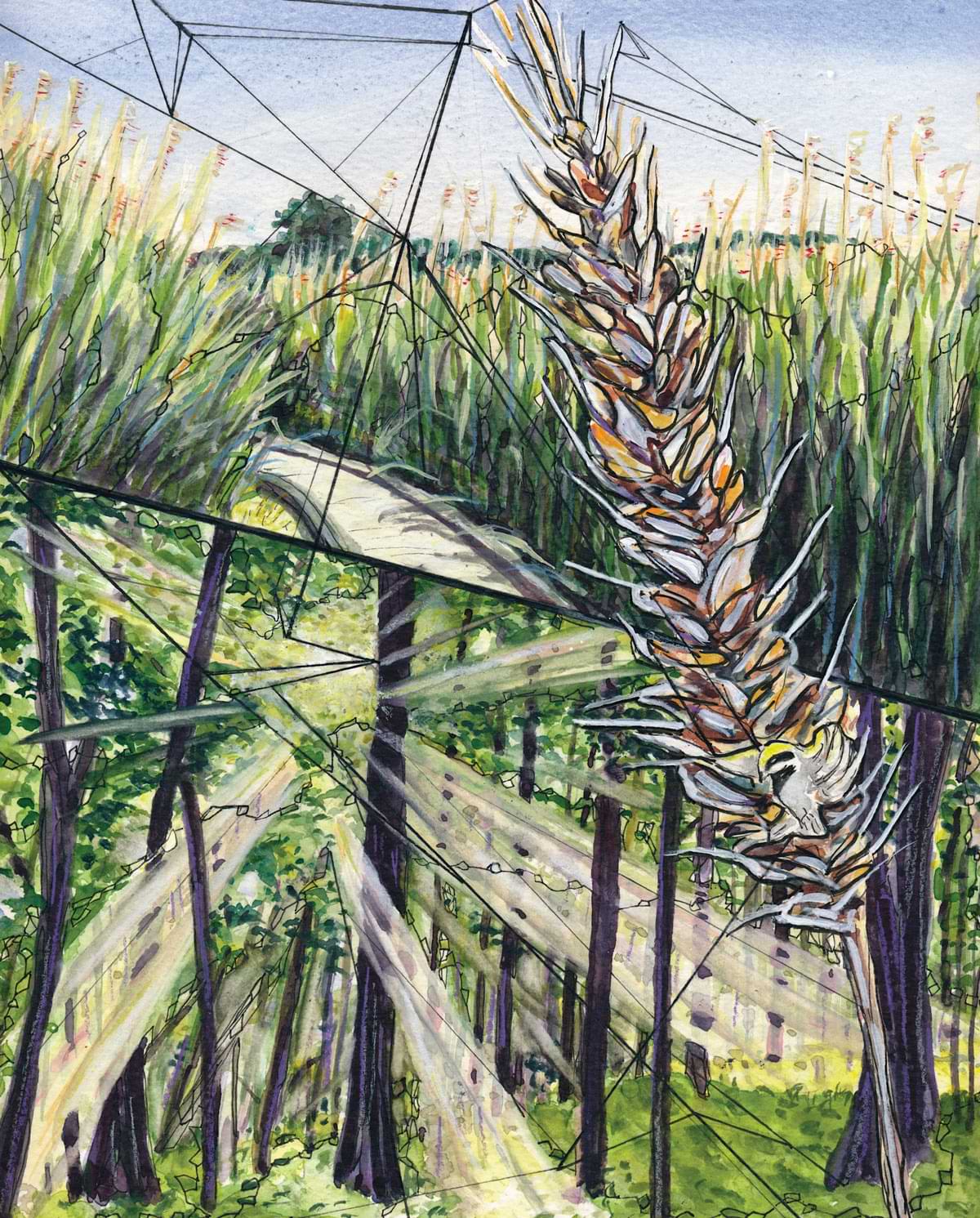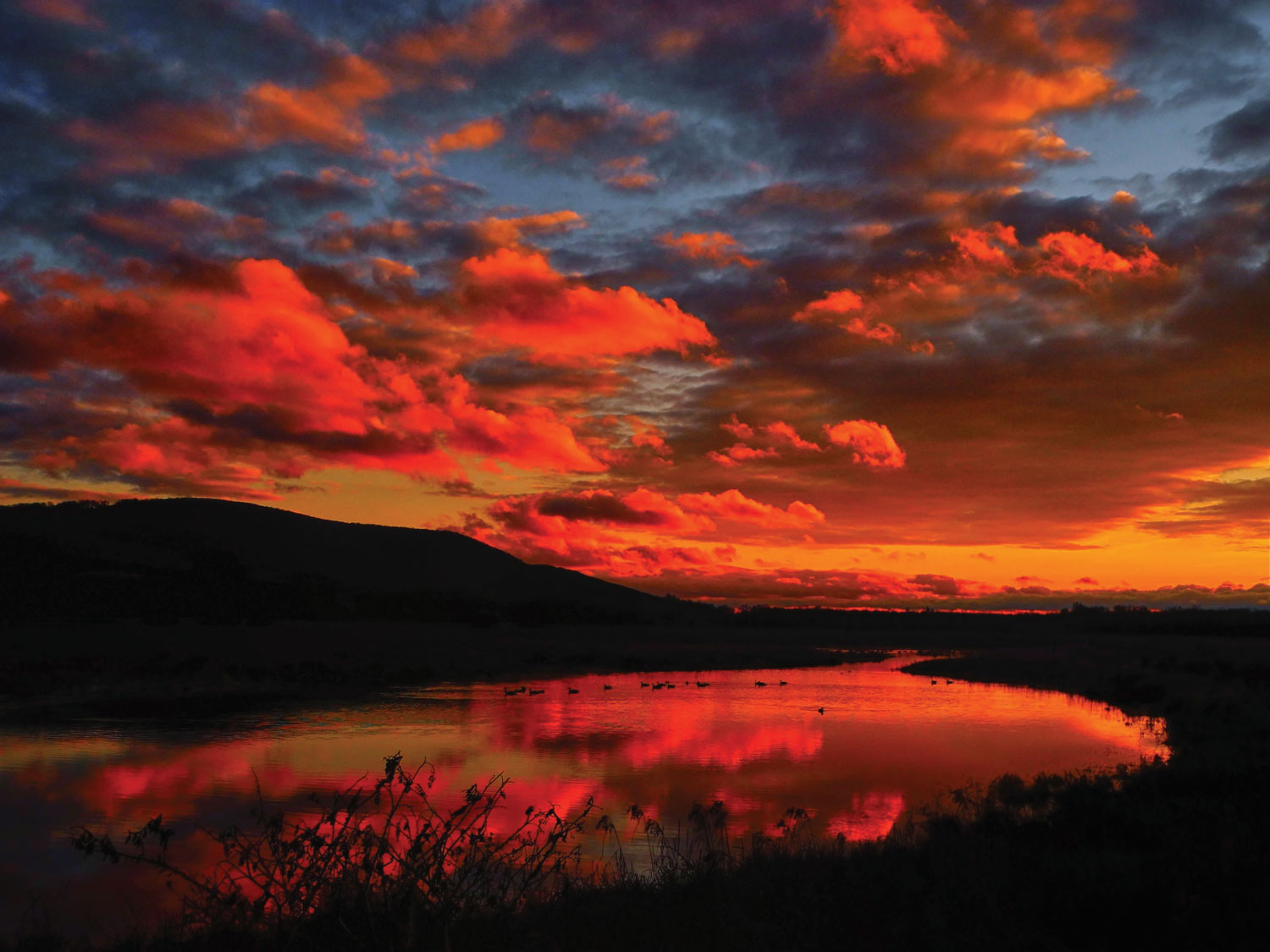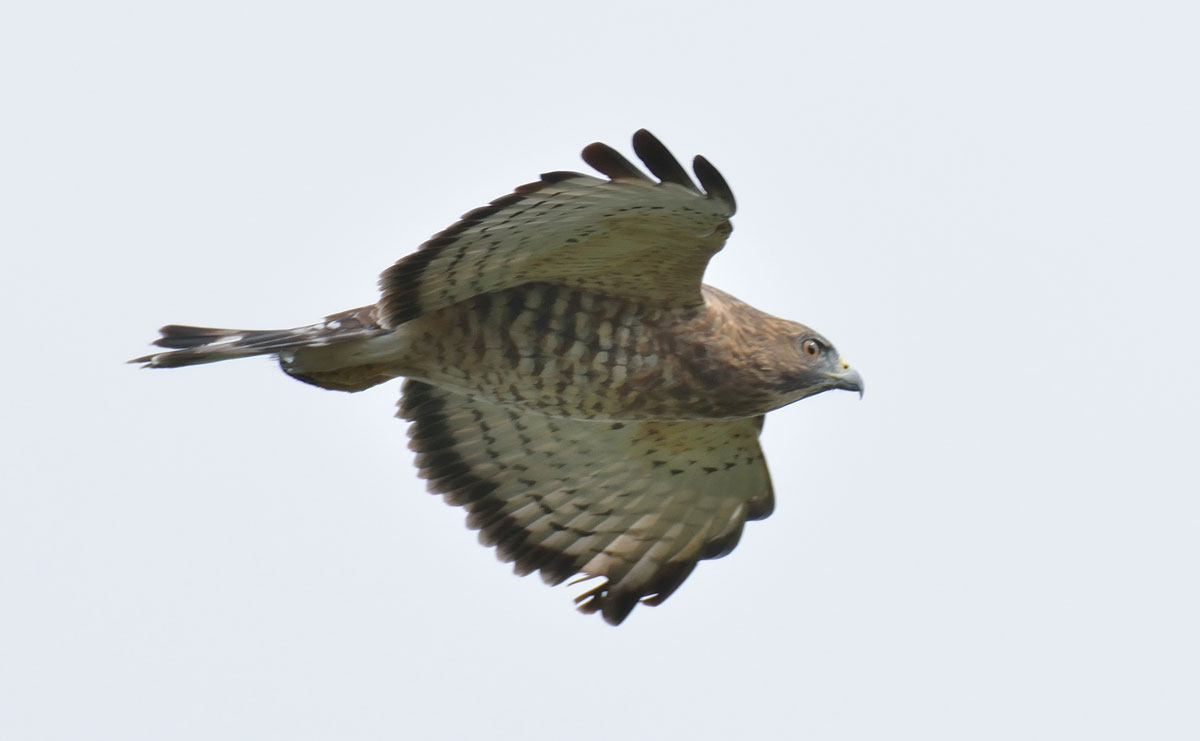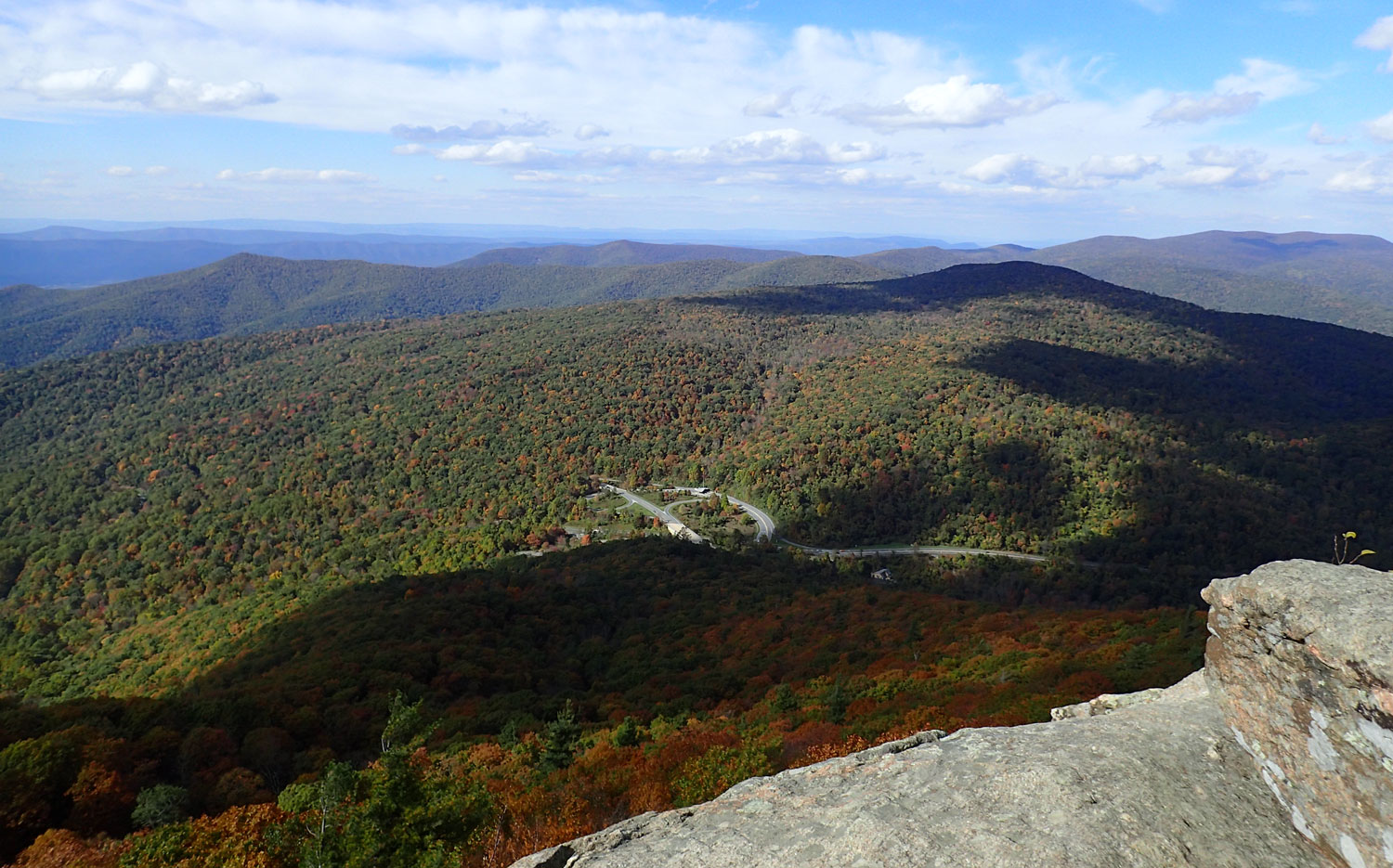
Watercolor, ink, and colored pencil on paper — features two vital landscapes connected by the Appalachian corridor: The magical light sifting through the trees in the southern Appalachian Mountains and a forest of grasses in Connecticut.
t is a burnished-gold morning in late September, and fall has begun to arrive in Shenandoah National Park. Orange and yellow leaves pepper the green foliage, catching the light like sequins. Although it still feels warm in the sun, a light, cool breeze brings the first hint of the autumnal weather to come. The year is rounding a corner, moving into a new season. Soon, thousands of migrating broad-winged hawks and other raptors will be seen overhead as they make their way south for the winter. Tall grasses in the meadows will turn rust-colored, and leaves will fall gently to the earth.
Watercolor, ink, and colored pencil on paper — features two vital landscapes connected by the Appalachian corridor: The magical light sifting through the trees in the southern Appalachian Mountains and a forest of grasses in Connecticut.
This morning, I am standing at the Pinnacle Picnic Area, my starting point for a 7.2-mile hike on the Appalachian Trail toward Marys Rock, a 3,500-foot summit in the park’s central district. The A.T. runs for 105 miles through Shenandoah, the northern terminus of which is just 163 miles south of the Trail’s halfway point in Pennsylvania. I will intersect with the Trail only briefly on this particular hike, but the white blazes remind me of the interconnectedness of the A.T.—stretching from Maine to Georgia and from past to present to future.
A century ago, Benton MacKaye envisioned the A.T. not just as a recreation destination for hikers and campers, but as a way to conserve the abundant natural resources of the Appalachian Mountains. In laying out his vision for the Trail, he talked of the ridges and trees, the rivers and lakes, even the fresh mountain air. He believed that the mountains, stitched together by the Trail, would lift the psyche of a people increasingly disconnected from nature, and that it would form a natural barrier against other perceived threats to humankind.
Today, the A.T. still abounds with natural resources, and, as the longest uninterrupted vegetated corridor in the East, the Trail corridor still forms a natural protection against some of the most pressing environmental threats to water and air quality and especially climate change. Already, the warming planet has shifted the seasonal cycles in the Appalachians — spring is starting sooner, fall is starting later — causing cascading impacts on forest and ecosystem health and native plant and animal species.


On my way toward Marys Rock, the sounds of cars on Skyline Drive fade, and I get a sense of the quiet power of these ridgelines and the resilience of these forests. I hear the breeze fluttering the vermilion leaves over my head and notice the crunch of my footfalls. Hiking north on the A.T., I follow switchbacks near the Jewell Hollow Overlook. Soon, the Trail narrows; tall, dense stands of twisty mountain laurel push in from either side. I think of the black bears whose populations have grown in these mountains, and I make noise, banging my hiking staff against the rocks that dot the A.T. Occasionally, I pass boulders as large as dinosaurs, and I imagine what turns of fate, tectonics, and erosion and trail-planning allowed such things to be here. Although I am hiking solo, I don’t feel alone. The Appalachian Trail reminds us that we are not the only species on this planet and that the natural resources we encounter do not exist solely for our own enjoyment.
Eventually, the Trail comes to a clearing where I take a water break at the Byrd’s Nest #3 shelter. All around me are the sentinels of the oak-hickory forest that dominates this section of the Appalachians. Where this landscape was once deforested in the early 20th Century, maples, birch, ash, and poplar trees now grow in abundance, protected by the A.T. corridor. As the largest forested region east of the Mississippi River, the Appalachians are essential for carbon sequestration, one of the most important tools to resist the effects of climate change. Trees absorb and sequester carbon for the length of their lifespans but also release it back into the atmosphere when they die, a process that happens slowly when trees perish naturally but is vastly accelerated when they are clear cut and removed for construction or some other purpose. According to recent research published in the journal Nature Climate Change, forests worldwide absorb twice as much carbon as they emit. And, the International Union for Conservation of Nature notes that one-third of all the carbon dioxide released from burning fossil fuels is absorbed by forests every year. This is why clear-cutting and development are accelerating climate change and why maintaining intact forests is so essential.
These forests also have value in terms of climate resiliency, allowing species the space to shift their traditional ranges in response to our warming planet and more extreme weather patterns. According to a 2017 report in Science, as high as 85 percent of all species could already be shifting their traditional ranges. When that is coupled with the loss of farmland and open space — the American Farmland Trust estimates that about 11 million acres of U.S. farmland were paved, fragmented, or converted to other uses between 2001 and 2016 — the Appalachian Trail corridor provides essential landscape connectivity for species to adapt to a changing climate and have a shot at survival.


Although development pressures are increasing on its borders, the A.T. corridor remains remarkably biodiverse — and may protect more rare, threatened, and endangered species than any other unit of the national park system. Biodiverse ecosystems are productive, nurturing ecosystems — with clean water, soil stability, and healthy wildlife that support people and creatures “downstream” in all sorts of ways. The landscapes of the A.T. support nine federally listed and 360 state-listed species of rare plants and animals, and more than 80 globally rare species.
Although I see gray squirrels frequently on my A.T. hike, for example, I know that another squirrel species — the Carolina northern flying squirrel — is a rare sight along the Trail. Federally listed as endangered, this cinnamon-colored rodent is a subspecies of northern flying squirrel that lives in the highest elevations of the southern Appalachians, itself one of only three flying squirrel species found in the United States. Numerous rare plant species, too, are protected along the length of the A.T., such as the endangered Roan Mountain bluet, known by its reddish-purple four-petaled blooms, and the Peter’s Mountain mallow, which grows in an isolated population in only one spot in southwest Virginia called the Narrows, accessible from the A.T.
Despite the protections afforded by the Trail corridor, those and countless other native species are increasingly threatened by an influx of invasive species. A recent study found that more than half of all national parks, including the A.T., are struggling with invasive animals, such as rats, pythons, and feral hogs. The sap-sucking hemlock woolly adelgid, for one, has caused serious damage and tree mortality along the A.T. in Shenandoah National Park and throughout the Appalachians, affecting more than 90 percent of the eastern hemlock’s range, according to some estimates. Ecological shifts caused by climate change often make it easier for nonnatives to take hold, and invasive plants often grow in monocultures that throw ecosystems out of balance. Throughout the Trail, hardy, widespread populations of invasive Chinese silvergrass and Japanese stiltgrass, in just two examples, have been crowding out native plants.
Threatened native plant species are of particular concern to the many bird species along the A.T. that depend on them. One of the most powerful aspects of the A.T. is its use as an avian flyway — a long green runway that provides a protected space for raptors and other birds to make their way south and north in their annual migrations. There is something ancient and beautiful about the pull towards the warmth of the sun, and back to the nesting grounds, that is represented by these yearly cycles of flight. The Trail allows us to mimic those ancient, instinctive acts ourselves, to learn from the birds about the value of movement and change, and also of returning home. As I head northward on this September day, I witness several broad-wing hawks catching thermal currents as they head southward. Other avian species that depend on the Appalachians include Cooper’s hawks, red-tailed hawks, bald eagles, golden eagles, peregrine falcons, and northern harriers, as well as invertebrate insects like the Monarch butterfly.



Photo by Chris D’Ambrosio
And yet, in recent decades, the loss of bird habitat and the reduction in bird populations have reached alarming levels, putting even more pressure on the spine of the Appalachians to remain a healthy and uninterrupted natural corridor for birds to use for shelter, food, and mating. Recent studies have estimated that North America has nearly three billion fewer birds today than it did 40 years ago. The tiny cerulean warbler, with only an eight-inch wingspan, has become a particular symbol of the over-all vulnerability of birds, with a U.S. population that has declined by more than 70 percent since 1970. The species has suffered habitat loss from mining, development, and deforestation on both ends of its cyclic journey — the treetops of the Appalachians and the wintering grounds in South America. The wood thrush, whose song inspired Henry David Thoreau to say, “wherever [someone] hears it, it is a new world and a free country,” has seen similarly alarming declines due to forest fragmentation and acidic rain. Even the colorful American kestrel, still considered one of the most common falcons in North America, has seen its population numbers decline by about half in the last 50 years.
As I start the slow climb toward Marys Rock, I can hear birds chirping in the trees, zipping from branch to branch in flashes of blue and brown and yellow. I think about how much the birds depend on us, but also how we depend on them, not just for enjoyment and delight while we hike, but to keep these ecosystems in balance. They eat insects and transfer seeds and pollen, they scavenge and keep pests at bay, they help to recycle nutrients. They are, as the author Terry Tempest Williams once wrote, “mediators between heaven and Earth.”
Finally, I reach a spur trail off the A.T. and begin my final ascent up to Marys Rock, one of the most storied and scenic views along the Appalachian Trail. Here I sit on a rocky outcropping that affords me a truly panoramic view of my surroundings. Blue-green ridges extend in all directions, and the sun-baked rock is warm beneath my legs. I think about the panoramic story of the Appalachian Trail, too, how it is much more than a footpath, but an essential conservation corridor for the myriad natural resources it supports.
Legend has it that Marys Rock was named after a local woman named Mary Savage who lived in a nearby mountain hollow. Another tale claims that a young girl named Mary Thornton climbed this mountain and returned home clutching a bear cub under her arm. As I sit at the summit, drinking in the 270-degree vista before me, a patchwork of rocks and ridges and trees and farmland, I think of the mythical Mary as a patron saint of this stretch of the A.T. I think of how the Trail has had so many patron saints over its nearly 100-year history, and how the mountains themselves have been peopled and cared for by Indigenous peoples for one-hundred times longer than that.
In his vision for the Trail, MacKaye described how the cities were paving over ever bigger swaths of land and cutting off ever larger numbers of people from the wildness of nature. The challenge of the 21st Century is to not only to protect this essential forest corridor, but to encourage a broader, more diverse range of people to experience the A.T. for themselves. And not just to experience it, but to appreciate it, understand it, and advocate for it. Ensuring widespread access to the Trail’s natural resources is not just good for conservation, it’s essential for social justice.
As the poet Walt Whitman famously wrote, “I am large, I contain multitudes.” So does the Appalachian Trail: It is, as it has always been for thru-hikers, section-hikers, and day hikers — as it is for me on the way to Marys Rock — a place of recreation and contemplation, a way to get outside oneself, and also a way back in. But, it is also habitat, refuge, flyway, tree tunnel, a long, green rampart against the global threat of climate change. Benton MacKaye was not a poet, not in a traditional sense, but through words and acts, he celebrated the potential of the A.T. and its multitudes. In our words and actions, we can do the same.
Kim O’Connell is a writer based in Arlington, Virginia, just a two-hour drive from her favorite trailheads in the Blue Ridge Mountains. In addition to publishing work in a range of national and regional publications, Kim has been an artist in residence at Shenandoah and Acadia national parks and teaches science writing for Johns Hopkins University.
–